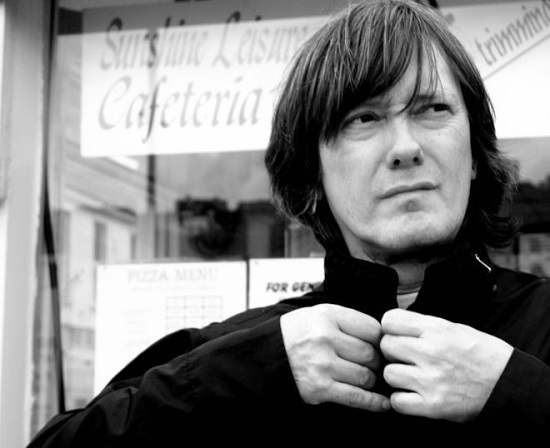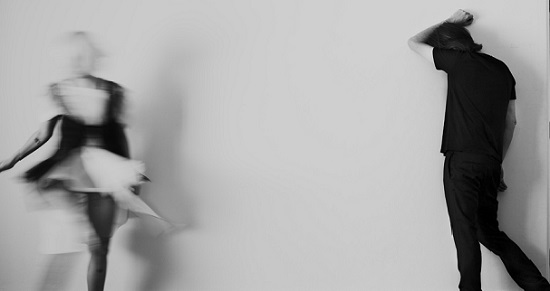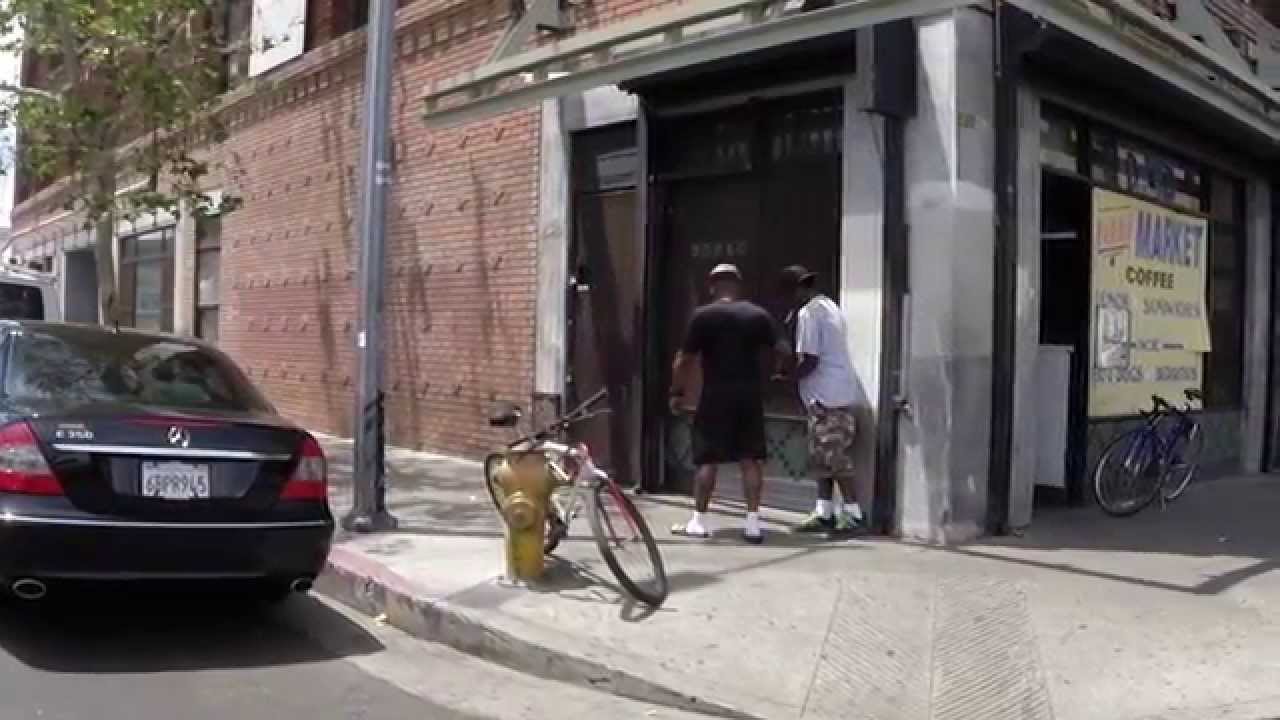Keyboardist Roger O’Donnell remains most well known for his membership in The Cure, a stint running off and on for over 25 years. But the London born O’Donnell has been professionally playing for almost four decades, whether backing other acts or working on his own. After a run of records towards the end of the previous decade, along with various releases by other acts via his 99X/10 label, O’Donnell concentrated more on Cure work and other efforts for a while but has come back strong on both fronts. He’s just released his first formal collaboration, Love And Other Tragedies, with cellist Julia Kent, while a couple of months ago 99X/10 released a striking self-titled album by Hannah In The Wars, led by New Zealand-born/London-based Hannah Curwood, which O’Donnell also produced.
Interviewed by phone at his combined home/studio in the UK, O’Donnell is affability itself – not to mention happily patient when I had to switch from Skype to a direct phone call.
On Love And Other Tragedies you had worked, initially, with a cellist friend in Toronto. Were these sessions just an experiment? Was this a remote recording online or just a back-and-forth? How did the initial seed plant there?
Roger O’Donnell: My friend Paul plays in a chamber orchestra in Toronto, and there was a big concert of guests and friends writing small pieces. So I wrote some pieces for him, and I went out and played them, and the leader of the orchestra asked me to write something for the whole orchestra. And that’s when I did the Quieter Trees suite, which was based on a David Hockney painting. It was around the same time that I was introduced to Julia, and the idea of working with her came about.
Had you heard her work in any context beforehand, or was it totally out of the blue?
ROD: I hadn’t heard of her heard her work, and it was a project called Post Romantic Empire, which is a project with an Italian group of artists. And they asked me to be a part of this project, and part of the project was introducing people to people that they didn’t know before, or that they’d never worked with. And it was then that it was suggested that I work with Julia.
This leaps ahead a bit, but does that explain a couple of the Italian titles on the album?
ROD: No. I just wanted it to be more international and I thought the notion of using French titles and Italian titles was more romantic as well. A convention among painters is to have the paintings have a French title as well as an English one, so kind of following on from that.
The idea of musicians being inspired by the visual arts; does this factor into your work in general? Is it one of those things where it can be any number of inspirations as you’ve worked over time?
ROD: I don’t get inspired to write music from listening to music, and I get inspired to write music, usually, by looking at paintings or popular artwork. And I find art galleries the most inspiring places for me, certainly. I studied art before I became a musician — well, around the same time, actually. It was quite a tradition for English musicians. So, it’s always run parallel for me, the creativity in art and design and in music and what we try to create. I think we run parallel paths with our creativity and what we’re trying to express. The outlet for artists is, obviously, painting, and mine is music. I also think that the Quieter Trees music is where I describe the painting in music, and I really like that kind of cross-genre collaboration. As well as collaboration, inspiration.
Turning, then, to the work on the album: was it something where you went in and created, rehearsed it, and then performed it? Or did it emerge out of the collaborations back and forth?
ROD: I guess it was less of a collaboration and more me writing the music and then Julia playing it. I wrote for that in my studio. I generally start with piano in all the things I write. It’s my primary instrument. And then I wrote the cello parts over some of the piano pieces, and then I sent all of it to Julia and she played them.
So it was a remote recording, then. Yeah. We’ve actually only met once, which some people find is a little strange. Today, it’s quite common to collaborate across the world. I collaborate with singers in Australia, and have done remixes for people in California. The world is a much smaller place now.
This is the type of thing that I’ve heard sometimes from other musicians, certainly not everyone. Is there something that’s always, no matter how good the circumstances, missed by someone not being there? Or is it just simply more typically like, the options are sometimes, "You do it this way, and sometimes you do it that way, and it’s all what you bring to it"?
ROD: I think that if we’d have been in the same room together, it would have been different. We would have played music differently. But we both work very well in our own environment and I think it’s six of one, a half-dozen of the other. I really, personally, like being comfortable when I’m playing. I don’t like the old red light syndrome in the studio. I like being able to work things out, moving slowly, and to do it over and over again as many times as I need to get it right. I don’t really respond that well to pressure. And I think you’ll find that if you talk to her, I think Julia’s the same. She works on her own in her own studio. Yes, it would have been entirely different if we’d recorded it together, but it is what it is.
So, how long did it take, ultimately, to record your pieces to the level that you were satisfied with?
ROD: I actually worked very quickly. I probably wrote and finished recording each piece within four or five hours. Once the creativity is flowing, the worst thing is if I get interrupted, then it disturbs it. But generally, it’s a very quick process. The sense of it was very much, not quite just simply a bare microphone and a bare room, but there was a very immediate "you are here" presence. I just wanted the listener to feel like they were sitting in the room with Julia and I. I didn’t want it to sound produced. And when I got the final files from Julia, her parts, I tried to mix it myself, to get that result, but at that point I decided to use somebody who I’ve worked with for over fifteen years, Paul Corkett, who’s worked with The Cure, and I knew that he would understand me exactly and that he would make it sound exactly the way I wanted it to, and he did, very quickly, do that.
Did the sequencing of the album, the assigning of the titles, and all that, come together pretty swiftly as well, or was that thought over, planned out?
ROD: No, it was all very straightforward and all very stream-of-consciousness, and everything suggested itself. Each of the stories was split into three parts to describe three main characters or three main parts of the story. And I don’t really spend much time thinking about those kind of things. They’re always very obvious to me. I’m always quite black-and-white on those kind of decisions.
Is the combination of piano and cello a fairly common one in classical music?
ROD: No, it’s not. You don’t often hear four cellos and a piano. It’s not an orchestral combination, like a string quartet would be violin, viola, cello — there are no pieces, as far as I know, classical pieces that are written for piano and four cellos. But I love the cello. It’s one of my favourite instruments. And also, it’s the closest to the human voice. So if you’re not going to use words to describe a story, and it’s going to be instrumental, then the cello is a good instrument.
How long have you had the home studio set-up? Is it something you tinker with, work on, adapt as time goes on?
ROD: I’ve been in the same place for nearly sixteen years now. It’s in the loft of a seventeenth-century barn. There’s a lot of resonance in there, and it’s just a very comfortable place. And sometimes I move where the desk is from one end to the other. Primarily, it stays the same, yeah.

The piano you use, is there anything particular of note on this particular instrument? Is it something you had around or brought into the recording?
ROD: You may find this interesting, you may not — it’s not a real piano. It’s a piano sample called Ivory, which is quite incredible. And even when I tell engineers that it’s not real piano, the mastering engineer who’s mastered my music for the last ten years — he didn’t believe me that it wasn’t a real piano. I have one in my house, but to be able to mic it and to record it for that kind of level, accuracy, and intimacy is incredibly difficult for me, because I’m not an engineer. And to be able to work with sampled piano allows me to edit and move things around and try different things. It’s actually an American Steinway that’s in New York, and it’s sampled for Ivory. It’s pretty amazing. It’s amazing to me. It really is striking. But you’re right; the technology these days and what you can do with it — I don’t need to tell you, I’m sure. It’s come a long way since I started playing the piano.
I’d imagine so. Stepping back a bit about something else you’ve done recently, the Hannah In The Wars album, which was really striking. The starker sound on your album is counterbalanced with a much more — the word is not "warmer," but the reverb, the layers, a different feeling there. Realizing that this is the difference between your own work and work you’re producing, was that an interesting experience in terms of working with different ways to approach recording, how it all came together?
ROD: I just think whatever the story takes to tell it — if you want to tell a very spare, sad kind of story with a piano and four cellos, then there’s no need to add anything else. But Hannah had a very good idea of what she wanted, and the people that played with her are all amazing musicians. Actually, my biggest role was to hold them back and make it more sparse. I’ve been a member of The Cure for maybe thirty years now, and one thing I’ve learned is less is more. If you can tell a story with four notes, don’t use eight. I tried to bring that out in them, because I really think that you can over-elaborate or over-exaggerate a story or a song. The songs and the arrangements were amazing. I was more of a mentor in that role. I was there and we did some recording in my studio as well, and I was able to introduce Hannah to Paul Corkett. So it’s kind of like a family, a nice group of people to work with.
Do you have any further acts you recently worked on or are working on that will be coming out with more work on the label, or just recording in the near future?
ROD: No. We’re not doing any other recording at the moment. I’m actually, foolishly, managing or helping to manage a band in L.A. called Queen Kwong, who are, again, a complete contrast to everything else — rock-punk with a very interesting female vocalist called Carré (Callaway). They’re not on this label, so that’s another hat I’m wearing, that of manager.
Is it the type of thing where you like to test yourself to try these different facets and see what can be done, because you experienced it in your own perspective working in a larger band?
ROD: Yeah, exactly. I think it’s really interesting to manage from the perspective of being an artist and knowing that side of the business. My biggest downfall is that I’m too emotionally involved, and when I usually end up getting more upset than anything else, it’s when things don’t sound right. But you know, I saw Queen Kwong play a couple of times and the last time I saw them in L.A. I was like, "She’s a star. What can I do to help?" It was just a matter of trying to make things happen rather than managing her in the traditional sense of the word. With a friend of mine we got the money together to bring them over to England to do some showcases, and it snowballed. It’s really nice at this stage in my career to be able to give something back. Not in any kind of charitable sense, but I’ve worked so much over the years. There’s another girl, a friend in Paris, and I went and watched her do her set, and I could see things she was doing that I’d done wrong, music stuff — not that they ever listen to you, but they’ve got to make their own mistakes. But you can encourage and you can guide a little bit. And I really enjoy that part of my career — not really part of my career, but a part of my life.
Realizing, I’m guessing, it’s not like you have some master plan or anything, but is there something that you would like to try next if the opportunity arose?
ROD: People say to me, oh, you should do something with film. I think that probably the next big thing but before that, the next thing I’m doing is music for ballet. Two ballets. We’re doing a version of the story of The Picture Of Dorian Gray at Les Saison Russe in Moscow. I’m doing a one-act ballet with a new Russian choreographer. So beyond that, I’ll probably do something with film. I spent quite a lot of time in Los Angeles, and most of my friends there are actors or producers or directors. And I just find that world fascinating. I spend so much of my time with actors and not musicians. I like the outside of my own world, somehow, and I just find it intriguing. That’s all I ever want to do, but I think that the way music works with acting is quite interesting. I don’t want to just write the soundtrack for a film, because this is a very cut-throat business. So I’d only do it if it was a very creative project with a director that was a friend. I see that in the future.
What, ultimately, would you like to do creatively as a musician that you haven’t had a chance to do yet but you see yourself working towards maybe further in the future as you get more comfortable, whether it’s an approach, a style, a level of performance? Is there anything that’s like, "Boy, if I could do that, that would really be something"?
ROD: I think the ballet projects pretty much are the biggest challenge for me right now. If they come to fruition, I’ll be very, very happy. I was invited to see a gala performance in London a few years ago, a ballet, and I sat there and I thought, "Wouldn’t it be amazing to write music that people will dance to like this, like a classical ballet situation?" And then it’s actually happening. It’s a very big project and a lot of work. If that happens, and I’m pretty sure it will, that would be the crowning moment of my career.



